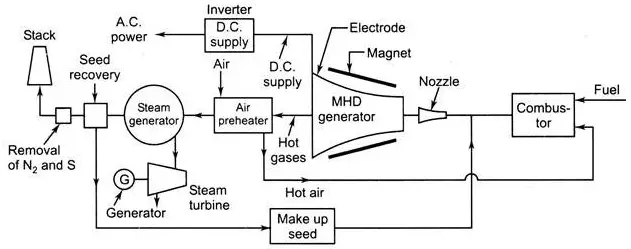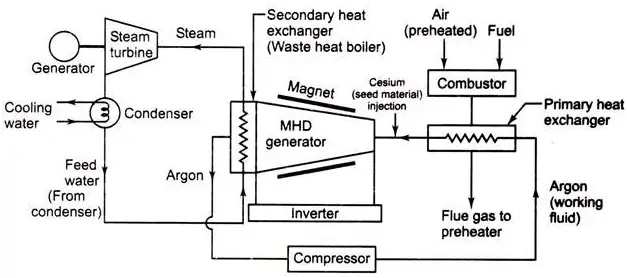When we talked about conventional thermal power plants the efficiency is in between 37 to 40%. In thermal plants, the fuel is burnt and the heat generated is used to convert water into steam. This steam is used to used to rotate turbine of an alternator. This is how steam energy is converted into mechanical energy and later mechanical energy is converted into electrical energy. Since in this process, there are many conversion from one form of energy to another, this results in losses and due to this the overall efficiency of these thermal power plant decreases.
Imagine a system where a heat energy is directly converted to electrical energy. The main advantage of such type of system is that higher efficiency is possible since there is no conversion of energy except heat energy to electrical energy. The direct conversion of heat energy into electrical energy is known as the magneto hydrodynamic (MHD) generation. The field of MHD was initiated by Hannes Alfven, for which he received the Nobel Prize in physics in 1970.
Principle of Operation of MHD Generator
The magneto hydrodynamic generation system converts heat energy into electrical energy based on the principle of Faraday’s law of electromagnetic induction. This law states that an EMF is induced in a conductor that is moving in a magnetic field. Here conductor can be in solid, liquid or gaseous form.
The hot ionizing gases at a temperature of about 2500 degree Celsius are passed through the MHD duct across a strong magnetic field which is at an angle 90° angle to the flow of the conducting fluid or gases (called plasma). The Ionisation of gas is produced either by thermal means i.e. at an elevated temperature or by seeding with a substance like cesium or potassium vapours which ionizes at relatively low temperatures. The atoms of seed element split off electrons. The presence of the negatively charged electrons makes the gas an electrical conductor.
Due to hot and ionization nature of gases, behave as a conductor and hence an EMF is induced across the electrodes as shown in the figure below. When the electrodes are connected to the load, current starts flowing through the load.

This system is usually advantageous if the MHD system is used along with thermal plants that utilize the heat of the exhaust gases leaving the MHD ducts. Due to this combination, the efficiency of a thermal power plant can be raised to 60%.
The materials used for various parts of the MHD system is shown in the table.

Types of Magneto Hydro Dynamic Generation Systems
- Open-Cycle MHD systems
- Closed-Cycle MHD Systems
1. Open-cycle MHD systems
- Working fluid after generating electrical energy is discharged to the atmosphere through a stack.
- Operation of MHD generator is done directly on combustion products.
- Temperature requirement about 2300°C to 2700 °C.
- Open cycle system is More developed

2. Closed-Cycle MHD Systems
- Working fluid is recycled to the heat sources and does is used again
- Helium or argon (with cesium seeding) is used as the working fluid
- Temperature requirement of about 1400 °C.
- Closed cycle system is Less developed

Advantages of MHD Generation
- A high conversion efficiency of around 50%.
- A large amount of power is generated.
- Better utilisation of fuel.
- Since it has no moving parts, so it is more reliable.
- Suitable for a peak power generation.
- Free of pollution.
- Less overall operational cost.
- It has the ability to reach the full power level as soon as it is started.
- The size of the plant is considerably smaller than conventional fossil fuel plants.
Disadvantages of MHD Generation
- MHD systems suffer from the reverse flow i.e. short circuits of electrons through the conducting gases (fluids) around the ends of the magnetic field.
